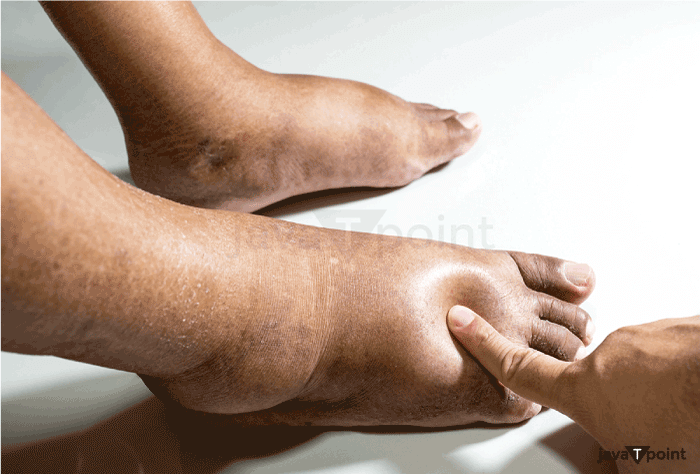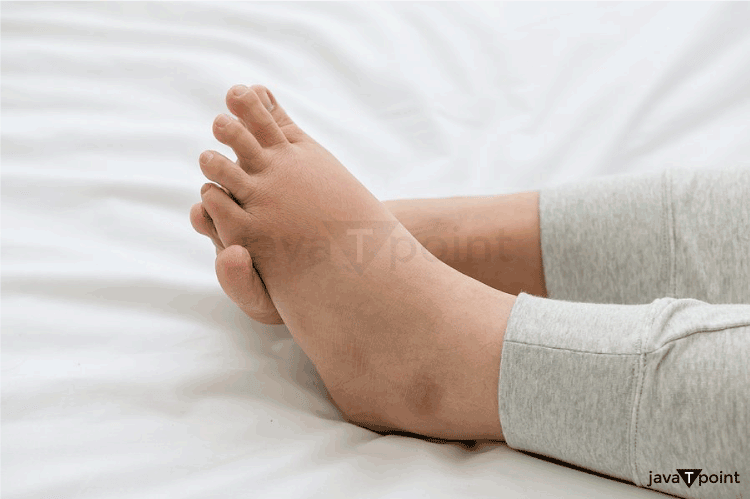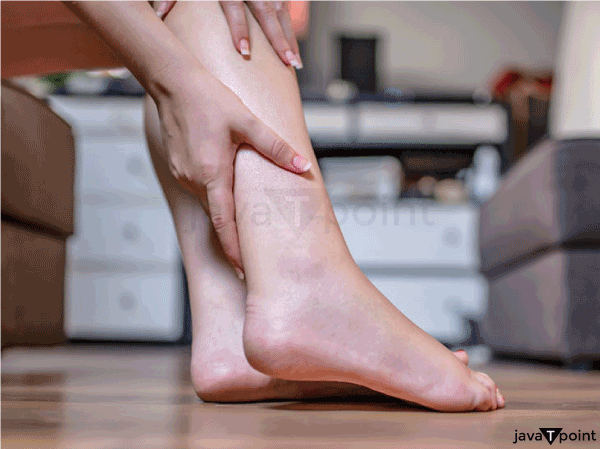Edema DefinitionEdema is defined as a medical condition caused by the accumulation of an excessive amount of watery fluid in the body's cavities or tissues. What is Edema?A build-up of fluid in body tissue is referred to as edema, usually known as -oedema," and also goes by fluid retention, dropsy, hydropsy, and swelling. Usually, the arms or legs are affected. The feeling of tight skin, heaviness in the area, and stiff joints are possible symptoms. Although it typically affects the skin, it can also harm other organs like the brain and lungs. Edema can be caused by medications and pregnancy. Congestive heart failure, renal illness, venous insufficiency, or liver cirrhosis are a few diseases that might cause it. Edema is frequently treated with compression clothing and salt restriction in the diet. A condition must also be treated when it results in edema. 
Types of Edema ConditionsEdoema comes in a variety of forms. Each one may be a sign of a variety of further medical issues. Edema types consist of:Peripheral edema: This condition impacts the hands, arms, legs, feet, and ankles. Swelling, puffiness, and trouble moving particular body parts are among the symptoms. Pulmonary edema: Breathing becomes challenging due to pulmonary edema, which develops when extra fluid builds up in the lungs. Congestive cardiac failure or a recent lung damage may cause this. It is a dangerous disorder that can cause a medical emergency, respiratory failure, and even death. Cerebral edema: The brain experiences cerebral edema. There are many different causes for it, several of which have the potential to be fatal. Among the signs include:
Macular edema: A significant consequence of diabetic retinopathy is macular edema. The area of the human eye that allows for detailed, center vision-the macula-swells. The person may observe modifications to their colour perception and central vision. Pitting edema: This form of edema, which can happen in peripheral edema, is marked by pressure on the skin that results in an indentation or pit. Periorbital edema: It is the medical term for swelling and inflammation around the eye or eyeballs. The fluid build-up is what causes the puffiness, which is typically momentary. Although there are additional places where edema can occur, the above-mentioned ones are the most typical. Edoema may be a sign of a number of dangerous medical disorders. If someone is worried about any swelling, it's crucial for them to consult a doctor. Edema Causes1. HeartThe heart's ability to pump blood should aid in maintaining proper blood vessel pressure. However, the pressure shifts can result in severe water retention if the heart starts to fail, a disease referred to as congestive heart failure. Water also builds up in the respiratory tract, where it creates a chronic cough, but it is most noticeable in the legs, feet, and ankles with this illness. Diuretics are typically used to treat this illness because, without them, the water retention could impair breathing and put additional strain on the heart. 2. KidneysKidney failure, in which the kidneys are unable to extract fluid from the circulation and convert it to urine, is another factor in severe water retention. Inflammation is frequently the first sign of kidney disease, as is the case with conditions like lupus or nephrotic syndrome. Legs and ankle swelling are the most common signs of this sort of water retention. 3. LiverA prominent cause of edema in the limbs and abdomen is liver cirrhosis or liver scarring. 4. ProteinProtein draws water and is crucial for maintaining the proper balance of water. The blood may not have enough protein in instances of severe protein deficit to draw water from the tissue gaps back into the capillaries. Due to this, malnutrition frequently manifests as an expanded abdomen. Due to the diet's lack of protein, the abdomen is enlarged from edema or water retention. Protein from the blood can leak out of capillary walls that are excessively porous and settle in the gaps between tissues. The water will then be continuously drawn in from the blood and build up in the tissue gaps like a magnet. 5. Other CausesLate pregnancy frequently results in swollen ankles, feet, and legs. The uterus's pressure on the large veins in the pelvis contributes to the issue. It normally goes away after the baby is delivered and is usually nothing to worry about, but it should always be reported to a doctor. Another common cause for the retention of water in the legs is inactivity. The leg veins can more effectively fight gravity while supplying blood to the heart's chambers with exercise. Too much fluid may be forced out of the leg capillary and into the tissue spaces if blood flows too slowly and begins to stagnate in the leg veins. Capillaries may rupture, creating minute blood stains beneath the skin. Varicose veins are an enlargement, discomfort, and dilation of the veins themselves. In addition to helping the blood continue to flow through the veins, muscle activity helps the lymphatic system perform its "overflow" job. Long-distance travel, protracted bed rest, immobility brought on by a handicap, etc., are all potential reasons for water retention. Exercises as simple as wiggling your toes and turning your ankles will assist in lessening it. Water retention is a common side effect of some drugs. These include beta-blockers, non-steroidal anti-inflammatory medications, and estrogens, including those used in replacement therapy for hormones or the combined oral contraceptive pill. 
Signs and SymptomsAreas AffectedWhen an organ is inflamed, such as with tendinitis or pancreatitis, an edema will develop there. Edema can occur in some organs due to tissue-specific processes. Some instances of edema in particular organs:
FormationSix different factors can influence Edoema formation:
Increased hydrostatic pressure frequently indicates salt and water retention by the kidneys. The Starling equation's forces control how much interstitial fluid is produced. Water tends to leak into the tissue due to hydrostatic pressure in blood vessels. As a result, the protein content in blood plasma & tissues differs. Since there is a higher concentration of protein in plasma, this has the effect of drawing water from the tissue back into the blood vessels due to colloidal or oncotic pressure. According to Starling's equation, for a given force imbalance, the rate of fluid leakage is governed by the disparity between the two forces as well as by the permeability of the exterior of the vessel to the water. Capillaries and post-capillary venules, which contain a membrane with a semi-permeable wall that enables water to enter more freely than protein, are where the majority of water leakage occurs. The permeability to water increases first when the spaces between the vessel wall's cells widen. Still, as the spaces get bigger, the permeability towards proteins also rises along with a decline in the reflection coefficient. Edoema may develop as a result of modifications to the parameters in Starling's equation, which may result in changes to the blood vessel's oncotic pressure, hydrostatic pressure, or permeability. The latter produces two results. It improves water flow and lessens the colloidal/oncotic fluid pressure differential by facilitating easier protein exit from the vessel. The lymphatic system, a different system of blood vessels, functions as an "overflow" and is capable of returning a significant amount of extra fluid to the bloodstream. However, the lymphatic system can become overloaded. If there is simply an excess of fluid or if the lymphatic system ends up clogged, the fluid continues to stay in the tissues and cause swelling in the abdomen, legs, ankles, and feet, as well as in other parts of the body. 
DiagnosisPitting edema and non-pitting edema are two different types of edema. Pitting edema occurs when pressure is exerted on a tiny area and released, leaving an indentation behind. The more typical variety of peripheral pitting edema is brought on by water retention. It can be brought on by local illnesses such as varicose veins, thrombus formation insect bites, rashes, systemic diseases, pregnancies in some women, and sometimes as a side effect of heart failure. When the indentation disappears, non-pitting edema is seen. It is connected to edema like myxoedema, lipoedema, and lymphedema. TreatmentEdoema treatment differs depending on the underlying cause, mainly if the underlying reason is a medical problem. For instance:
Medications to Cure EdemaYou can take a few actions to prevent fluid from accumulating in your body in addition to curing the root cause of edema:
Next TopicEngine- Definition
|
 For Videos Join Our Youtube Channel: Join Now
For Videos Join Our Youtube Channel: Join Now
Feedback
- Send your Feedback to [email protected]
Help Others, Please Share









